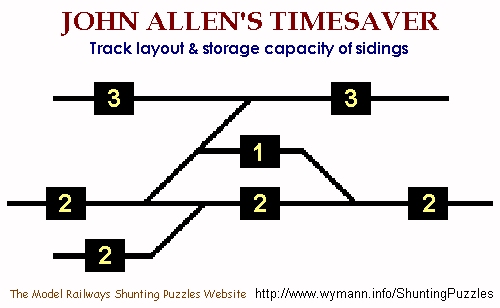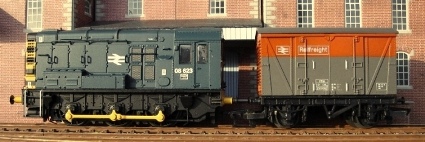|
| |
TIMESAVER
TRACKPLAN & LAYOUT SIZE
|
| |
| The
original "Timesaver" track layout as conceived
by John Allen requires 5 switches (the original layout
used "Y" switches) to build up a layout with 5
sidings and a runaround track, providing access to 5
destinations (e.g. industries) receiving and sending
goods by rail. |
| |

The
twin copy of the original Timesaver (on display at the San Diego Model Railroad
Museum)
|
| |
| Most
importantly, each section of the track plan has a
specific length which is measured in terms of the number
of rolling stock it can hold. |
| |
|
This in cludes both the
freight cars and the locomotive used, meaning
that a siding with a capacity of 2 should be able
to hold either two freight cars or one freight
car plus locomotive (the original
Timesaver was conceived to work with five 40ft
freight cars and 1 short switcher).
Restricting
the length of the tracks is a key element of the
switching game, because it limits the number of
freight cars you can temporarily leave on a
siding while getting another car to its actual
destination. In order to end up with a working
Timesaver layout, the lengths of the individual
sidings as given above must be strictly observed.
|
|
 |
|
| |
| With
the track layout and storage capacities indicated above,
it is easy to determine the length of a Timesaver layout
in any modelling scale - you just measure the longest
item to be used on the layout and multiply this with the
storage capacity index of the individual sidings (e.g. if
you use 50ft boxcars instead of 40ft boxcars, the tracks
need to be lengthened accordingly). |
| |

A short British Cl 08
switcher and an even shorter wheelbase freight
car (VEA) cut down considerably on the required
length of the sidings of a Timesaver
|
|
By defining the lengths of
the sidings in terms of the exact number of
rolling stock they can hold, the scheme can
therefore easily be adapted for any scale and, in
fact, any prototype.
Special
care needs to be taken with regard to the
runaround track, making sure that the clearances
work on all sides. So before starting to build a
Timesaver layout, you will obviously need to know
the projected size of the layout.
|
|










